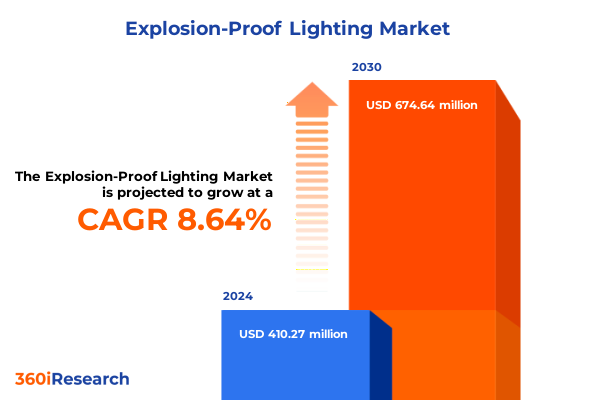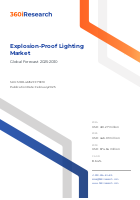The Explosion-Proof Lighting Market size was estimated at USD 410.27 million in 2024 and expected to reach USD 446.01 million in 2025, at a CAGR 8.64% to reach USD 674.64 million by 2030.

Setting the Stage for Explosion-Proof Lighting Opportunities
In an era of heightened safety standards and accelerated industrial expansion, explosion-proof lighting has transitioned from a specialized niche into a strategic imperative for sectors operating in hazardous environments. Manufacturers, miners, oil and gas operators, and chemical processors are confronted with stringent regulations and the imperative to mitigate risks while sustaining operational continuity. Beyond compliance, these lighting solutions deliver reliability amid flammable atmospheres, enabling round-the-clock productivity in the most demanding conditions.
This executive summary distills the pivotal factors reshaping the explosion-proof lighting market: evolving safety directives, rapid LED adoption, and growing demand for smart and solar-powered systems. With a sharp focus on US tariff impacts, core market segments, regional dynamics, and competitive benchmarks, this overview equips decision-makers with the insights needed to navigate supply-chain disruptions, capitalize on emerging technologies, and align with sustainability goals. As industrial leaders chart their growth strategies, understanding these foundational trends and pressures will be critical to securing both safety and profitability in hazardous locations.
Key Drivers Redefining the Explosion-Proof Lighting Landscape
The landscape of explosion-proof lighting is being fundamentally redefined by a confluence of technological, regulatory, and operational shifts. First, the rapid migration to LED technology has slashed energy consumption by up to 60%, while enhancing service life and reducing maintenance downtime. Digital integration further amplifies value: connected lighting systems now enable automated dimming, remote monitoring, and predictive maintenance in offshore platforms and chemical storage facilities.
Concurrently, regulators worldwide are tightening hazardous-location classifications, mandating higher ingress protection ratings and stricter Zone 0, 1, and 2 certifications. This regulatory evolution compels suppliers to innovate robust enclosures rated at IP67 or beyond, ensuring reliable performance under extreme dust, moisture, and explosive gas exposures.
Safety and sustainability drivers also intersect: solar-powered and battery-backed emergency lighting solutions are gaining traction in remote mining operations and offshore rigs, where grid access is limited. Smart lighting ecosystems increasingly integrate with broader industrial IoT platforms, offering real-time operational analytics and streamlined compliance reporting.
Together, these transformative forces are not only elevating performance benchmarks but also broadening the value proposition of explosion-proof lighting systems, positioning them as indispensable components of modern industrial infrastructure.
Assessing the Impact of New US Tariffs on Explosion-Proof Lighting
Starting in 2025, newly imposed United States tariffs on imported explosion-proof lighting components have triggered significant reverberations across global supply chains. Additional duties on finished fixtures and critical electronics have translated into price adjustments of 10% to 25% for end users, prompting engineering teams to reevaluate sourcing strategies and total cost of ownership.
Manufacturers are accelerating their shift towards localized production or near-shore assembly to mitigate the tariff burden and protect margin structures. This strategic pivot, however, demands capital investments in certified manufacturing facilities that can meet rigorous hazardous-location standards, including Zone 0 and Zone 1 approvals. Simultaneously, distributors are realigning inventory buffers to pre-empt supply interruptions, supporting key industrial accounts in mining and petrochemical sectors.
On the demand side, heightened costs have spurred conversations around LED retrofit programs and modular system upgrades that deliver rapid ROI through reduced energy consumption and extended maintenance cycles. Service providers are packaging value-added offerings-such as turnkey installation and post-warranty maintenance contracts-to maintain competitiveness amid cost headwinds.
Overall, these cumulative tariff effects are redefining cost structures, reshaping procurement roadmaps, and accelerating the adoption of high-efficiency, locally produced explosion-proof lighting solutions.
Unpacking Core Market Segmentation in Explosion-Proof Lighting
The explosion-proof lighting market is organized across multiple dimensions to address diverse industry needs and environmental challenges. Based on application, segments include manufacturing-spanning automotive manufacturing and food processing-mining, with coal, gold and stone quarry operations, oil and gas distribution terminals, offshore platforms and refineries, and petrochemical environments encompassing chemical plants and storage areas. In terms of product type, stakeholders evaluate fluorescent lighting through compact and tubular variants, incandescent offerings via high-output and robust-build models, and LED solutions ranging from panel lights to portable fixtures and spotlights.
Safety compliance drives certification segmentation: hazardous-location ratings cover Zones 0, 1 and 2, while ingress protection focuses on IP65 and IP67 standards. The end-user view separates commercial venues like exhibition halls and malls from industrial sites such as warehouses and workshops. Installation typologies distinguish surface-mounted ceiling and wall surfaces from suspended mounting using cable suspension or pendant systems. Technological innovations further refine the market, differentiating emergency lighting with battery backup and self-contained units, smart lighting featuring automated dimming and connected systems, and solar-powered options integrating panels or standalone energy units. Voltage requirements split between high-voltage 230V and 480V applications and low-voltage 12V and 24V configurations.
Amid these segments, LED panel lighting for petrochemical storage areas and IP67-rated smart fixtures for offshore platforms are emerging as high-growth niches, driven by demand for energy efficiency, regulatory compliance and digital remote-monitoring capabilities.
This comprehensive research report categorizes the Explosion-Proof Lighting market into clearly defined segments, providing a detailed analysis of emerging trends and precise revenue forecasts to support strategic decision-making.
- Application
- Product Type
- Equipment Certification
- End User
- Installation Type
- Technology
- Voltage
Regional Dynamics Shaping the Explosion-Proof Lighting Market
Regional market dynamics reveal distinct growth trajectories and strategic imperatives. In the Americas, infrastructure modernization in oil and gas, coupled with a resurgence in mining exploration, is fueling strong demand for high-efficiency LED systems and localized manufacturing. The need to comply with recent tariff regulations has accelerated investments in domestic assembly and turnkey service models.
Across Europe, Middle East & Africa, stringent EU and Gulf Cooperation Council safety standards are propelling upgrades to IP67-certified smart lighting systems, particularly within petrochemical complexes and automotive manufacturing plants. Sustainability directives in Western Europe further incentivize solar-powered and emergency lighting solutions that reduce carbon footprints and ensure resilience during power disruptions.
The Asia-Pacific region stands out for its rapid industrialization and large-scale chemical and mining projects. Countries such as China, India and Australia are driving purchase volumes for Zone 1 and Zone 2 certified LED fixtures, often prioritizing partners with local production capabilities and robust after-sales networks. Additionally, government incentives for smart-grid integration are creating a fertile environment for automated dimming platforms and connected lighting ecosystems.
This comprehensive research report examines key regions that drive the evolution of the Explosion-Proof Lighting market, offering deep insights into regional trends, growth factors, and industry developments that are influencing market performance.
- Americas
- Asia-Pacific
- Europe, Middle East & Africa
Leading Companies Driving Innovation in Explosion-Proof Lighting
Innovation and consolidation characterize the competitive landscape, with global and specialized players vying for leadership. ABB Ltd. is leveraging its strong presence in power and automation to integrate connected lighting into broader industrial IoT offerings, while Abtech Ltd. emphasizes niche expertise in custom hazardous-location solutions. Adolf Schuch GmbH and Eaton Corporation Plc excel in high-voltage applications and heavy-duty enclosures, and Emerson Electric Co. and General Electric Company bring extensive R&D resources to advance LED and smart controls.
Hatch Lighting and Hubbell Inc. are gaining traction in modular retrofit kits, targeting legacy installations in petrochemical and mining operations. Larson Electronics and LEDVANCE LLC focus on portable and rugged fixtures for temporary and maintenance contexts. Osram Licht AG and Philips Lighting Holding B.V. continue to push boundaries in LED efficacy and connected platform interoperability, while Phoenix Products LLC, Victor Lighting and WorkSite Lighting differentiate through specialized emergency and solar-powered solutions tailored to remote or off-grid sites.
Collectively, these firms are investing in compliance, certification, and digital integration, forging partnerships with system integrators and aftermarket service providers to capture long-term value in hazardous locations.
This comprehensive research report delivers an in-depth overview of the principal market players in the Explosion-Proof Lighting market, evaluating their market share, strategic initiatives, and competitive positioning to illuminate the factors shaping the competitive landscape.
- ABB, Ltd.
- Abtech Ltd.
- Adolf Schuch GmbH
- Eaton Corporation Plc
- Emerson Electric Co.
- General Electric Company
- Hatch Lighting
- Hubbell Inc.
- Larson Electronics
- LEDVANCE LLC
- Osram Licht AG
- Philips Lighting Holding B.V.
- Phoenix Products LLC
- Victor Lighting
- WorkSite Lighting
Strategic Recommendations to Propel Market Leadership
Industry leaders should prioritize a dual approach that balances technological advancement with regulatory agility. First, accelerate development of LED panels and portable fixtures certified for IP67 and Zone 1 environments to meet rising safety requirements while improving energy efficiency. Next, expand local manufacturing or assembly footprints to mitigate tariff exposure and foster closer collaboration with key industrial accounts.
Simultaneously, embed smart-lighting capabilities-such as automated dimming, remote diagnostics, and predictive maintenance-into core product lines to enhance operational transparency and reduce downtime costs. Building strategic alliances with IoT platform providers can unlock new service revenue streams and fortify customer retention.
Furthermore, position solar-powered and battery-backed emergency units as integrated solutions for remote mining sites and offshore platforms, leveraging government incentives for renewable technologies. Finally, optimize supply-chain resilience by diversifying supplier networks, investing in buffer inventories, and streamlining compliance processes for hazardous-location certifications.
Explore AI-driven insights for the Explosion-Proof Lighting market with ResearchAI on our online platform, providing deeper, data-backed market analysis.
Ask ResearchAI anything
World's First Innovative Al for Market Research
Synthesis of Insights and Strategic Outlook
As explosion-proof lighting continues to evolve under the influence of regulatory mandates, technological breakthroughs, and shifting trade policies, stakeholders must remain vigilant and proactive. This study underscores the importance of aligning product portfolios with emerging safety standards and energy-efficiency benchmarks while diversifying regional manufacturing and supply-chain strategies to counteract geopolitical uncertainties.
By capitalizing on LED and smart-lighting innovations, companies can unlock new value propositions-spanning remote diagnostics, modular retrofits, and renewable integration-that resonate with both commercial and industrial end users. Moreover, a focused push into high-growth segments, such as IP67-rated offshore fixtures and solar-powered emergency systems, will secure competitive differentiation.
Ultimately, a data-driven approach to segmentation, combined with agile responses to tariff shifts and collaborative partnerships across the value chain, will be critical for sustaining growth and safeguarding operational integrity in hazardous locations.
This section provides a structured overview of the report, outlining key chapters and topics covered for easy reference in our Explosion-Proof Lighting market comprehensive research report.
- Preface
- Research Methodology
- Executive Summary
- Market Overview
- Market Dynamics
- Market Insights
- Cumulative Impact of United States Tariffs 2025
- Explosion-Proof Lighting Market, by Application
- Explosion-Proof Lighting Market, by Product Type
- Explosion-Proof Lighting Market, by Equipment Certification
- Explosion-Proof Lighting Market, by End User
- Explosion-Proof Lighting Market, by Installation Type
- Explosion-Proof Lighting Market, by Technology
- Explosion-Proof Lighting Market, by Voltage
- Americas Explosion-Proof Lighting Market
- Asia-Pacific Explosion-Proof Lighting Market
- Europe, Middle East & Africa Explosion-Proof Lighting Market
- Competitive Landscape
- ResearchAI
- ResearchStatistics
- ResearchContacts
- ResearchArticles
- Appendix
- List of Figures [Total: 30]
- List of Tables [Total: 1119 ]
Engage Ketan Rohom for Full Market Research Insights
To access the full market research report and engage in tailored discussions on these strategic imperatives, please reach out to Ketan Rohom, Associate Director of Sales & Marketing. Ketan will guide you through comprehensive data, detailed segment analyses, and customized recommendations designed to fortify your position in the explosion-proof lighting market. Contact him today to secure your competitive advantage and drive informed decision-making.

- How big is the Explosion-Proof Lighting Market?
- What is the Explosion-Proof Lighting Market growth?
- When do I get the report?
- In what format does this report get delivered to me?
- How long has 360iResearch been around?
- What if I have a question about your reports?
- Can I share this report with my team?
- Can I use your research in my presentation?




